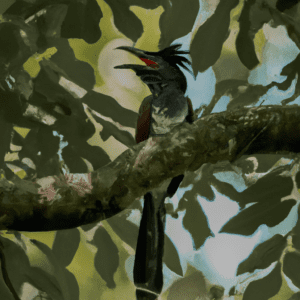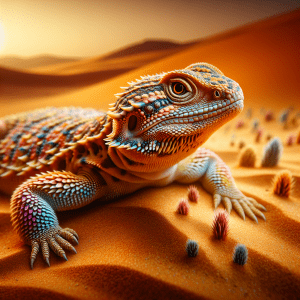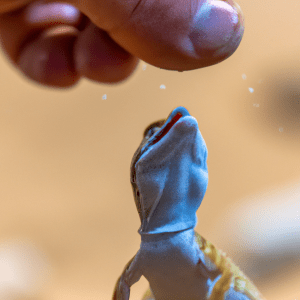Introduction to Sahara Lizards
Have you ever been captivated by the enchanting world of Sahara lizards? Picture this: the vast, golden dunes stretching endlessly before you, the scorching sun beating down as you eagerly scan the landscape for signs of movement. It’s a thrill like no other to spot a sleek lizard darting across the sand, blending seamlessly into its arid surroundings.
Let me share with you a personal anecdote from my own adventure in the Sahara. As I ventured into the desert, my eyes were fixated on the shifting sands, hoping to catch a glimpse of these elusive creatures. Suddenly, a flash of movement caught my attention, and there it was—a magnificent Sahara lizard, its scales shimmering in the sunlight as it navigated the harsh terrain with effortless grace. In that moment, I felt a deep connection to the rugged beauty of the desert and the remarkable creatures that call it home.
The Sahara desert is home to a diverse array of lizard species, each uniquely adapted to survive in this harsh environment. From the agile sandfish lizard to the formidable spiny-tailed lizard, these reptiles exhibit a fascinating range of behaviors and characteristics. Did you know that some Sahara lizards have evolved specialized adaptations, such as fringed toes for better traction on sandy terrain or camouflaged skin patterns to evade predators?
Exploring the world of Sahara lizards offers not only a glimpse into the wonders of nature but also raises important questions about conservation and habitat preservation. As human activities encroach on the fragile ecosystems of the Sahara, these remarkable reptiles face increasing challenges to their survival. Understanding the significance of protecting these species is crucial in ensuring the continued biodiversity of this unique desert region.
So, next time you find yourself gazing out into the vast expanse of the Sahara, keep an eye out for the subtle movements and shapes that may reveal the presence of these incredible lizards. Who knows what wonders you may discover in the hidden world of Sahara reptiles?
Diversity of Lizard Species in the Sahara
You won’t believe the incredible variety of lizard species that call the Sahara desert home! From the tiny geckos that scurry across the sand to the majestic monitors that roam the rocky terrain, there’s a lizard for every corner of this vast expanse.
I remember my trip to the Sahara last year when I first encountered a Saharan horned viper, camouflaged perfectly against the desert backdrop. It was a surreal moment, realizing how these creatures have adapted to thrive in such harsh conditions. Each species has its own unique features and behaviors that make them perfectly suited to their environment.
Did you know that the Sahara is home to over 70 different species of lizards? Some, like the spiny-tailed lizards, have evolved special adaptations to survive the scorching heat, while others, such as the agile fringe-toed lizards, are experts at navigating the sandy dunes with ease.
The diversity of lizard species in the Sahara is not just fascinating from a scientific standpoint; it also plays a crucial role in maintaining the delicate balance of the desert ecosystem. These lizards are not just fascinating creatures to observe; they are key players in the intricate web of life in the Sahara.
Next time you’re exploring the Sahara, keep an eye out for these incredible creatures. Take a moment to appreciate the beauty and complexity of the lizard species that have carved out their niche in this unforgiving landscape. Who knows what other secrets and wonders of nature you might uncover along the way?
Characteristics and Adaptations of Sahara Lizards
Have you ever stopped to marvel at the incredible adaptations of Sahara lizards? These creatures are true masters of survival in the harsh desert environment. Just imagine, some species of Sahara lizards have developed specialized scales that help them blend seamlessly into the arid landscape, making them almost invisible to predators and prey alike. It’s like nature’s own stealth mode!
These adaptations go beyond just camouflage. Sahara lizards have also evolved unique features to help them regulate their body temperature in the scorching heat. Some species have developed the ability to absorb water through their skin, allowing them to stay hydrated in the water-deprived desert. Isn’t that fascinating?
When you observe Sahara lizards up close, you’ll notice their intricate scales and patterns that serve more than just an aesthetic purpose. Each tiny detail plays a crucial role in their survival. And let’s not forget their nimble movements and lightning-fast reflexes, which are essential for evading predators and catching prey in the unforgiving desert environment.
As you delve deeper into the world of Sahara lizards, you’ll realize the sheer diversity and ingenuity of these remarkable creatures. From the vibrant colors of the painted agama to the cryptic patterns of the sandfish, each species has its own story to tell. It’s like a living tapestry of evolution right before your eyes.
So, the next time you find yourself in the Sahara desert, take a moment to appreciate the beauty and resilience of these incredible lizards. Who knows, you might just uncover a newfound admiration for these small but mighty inhabitants of the desert.
Best Practices for Observing Lizards in the Desert
Have you ever tried observing lizards in the desert? It’s a thrilling experience that requires patience and a keen eye for detail. I remember the first time I went lizard watching in the Sahara – the vast expanse of the desert landscape seemed almost surreal, and I was eager to spot some of the unique lizard species that call this harsh environment home.
One interesting fact about observing lizards in the desert is that they have evolved remarkable adaptations to survive in such extreme conditions. From their ability to blend in seamlessly with their surroundings to their efficient thermoregulation mechanisms, Sahara lizards are truly fascinating creatures to study.
When it comes to observing lizards in the desert, one practical tip I can offer is to be mindful of their behavior and habitat preferences. Lizards are often most active during the early morning or late afternoon when temperatures are more moderate, so these are the best times to catch a glimpse of them in action. Additionally, knowing the specific habitats where certain lizard species are commonly found can increase your chances of spotting them.
As you embark on your own lizard-watching adventure in the Sahara, consider the broader significance of these reptiles in the ecosystem. Lizards play a crucial role in maintaining balance in the desert food chain, preying on insects and serving as a food source for larger predators. By observing and appreciating these creatures, we can gain a deeper understanding of the intricate web of life in the Sahara desert.
So, next time you find yourself in the Sahara, take some time to observe the fascinating world of lizards that inhabit this unique environment. You never know what wonders you might discover in the desert sands.
Endangered Lizard Species in the Sahara
Have you ever considered the vital role that lizards play in the delicate ecosystem of the Sahara desert? These fascinating creatures are not only a sight to behold but also hold significant importance in maintaining the balance of their environment.
Imagine trekking through the vast expanse of the Sahara, with the scorching sun beating down on the golden sands around you. As you scan the horizon, you may catch a glimpse of a Sahara lizard darting across the dunes, its sleek body blending seamlessly with its surroundings. These resilient creatures have adapted to thrive in one of the harshest environments on Earth, showcasing remarkable characteristics that enable them to survive in extreme conditions.
One interesting fact about Sahara lizards is their diverse range of species that have evolved distinct features to suit their specific habitats within the desert. From the agile sand lizards that swiftly navigate the sandy terrain to the spiny-tailed lizards with their impressive defensive tactics, each species has its unique adaptations that make them well-suited for life in the Sahara.
However, despite their resilience, Sahara lizards face numerous challenges, including habitat loss due to human activities and climate change. Conservation efforts are crucial to protect these creatures and ensure the preservation of their natural habitats for future generations to appreciate and study.
As you delve deeper into the world of Sahara lizards, consider the broader implications of their presence in the desert ecosystem. How do these creatures contribute to the overall biodiversity of the Sahara, and what can we do to safeguard their existence in the face of mounting environmental threats?
By exploring the significance of Sahara lizards and the intricate web of interactions they have with their surroundings, we gain a newfound appreciation for these remarkable creatures and the vital role they play in maintaining the delicate balance of the Sahara ecosystem.
Importance of Lizards in the Sahara Ecosystem
Have you ever stopped to think about the vital role that lizards play in the delicate balance of the Sahara ecosystem? It’s truly fascinating to consider how these seemingly small creatures have a significant impact on their environment.
When you delve into the importance of lizards in the Sahara ecosystem, you start to realize just how interconnected all living organisms are. Lizards act as both predators and prey, contributing to the regulation of insect populations and serving as a food source for larger animals. Their presence helps maintain the biodiversity of the region, ensuring that no single species dominates the ecosystem.
Beyond their ecological significance, Sahara lizards also serve as indicators of environmental health. By studying the populations and behaviors of these reptiles, researchers can gain valuable insights into the overall well-being of the desert ecosystem. Changes in lizard populations can signal shifts in climate, habitat quality, and other environmental factors that may impact the entire region.
Consider this: what would happen if Sahara lizards were to disappear suddenly? How would it affect the plants they feed on, the animals that feed on them, and the overall balance of the ecosystem? These questions highlight the intricate web of life in the Sahara and emphasize the critical role that every species, no matter how small, plays in maintaining the delicate equilibrium of nature.
So, the next time you spot a lizard darting across the desert sands, take a moment to appreciate not just its beauty, but also its importance in the grand scheme of things. These creatures may seem small and insignificant, but their presence is a testament to the remarkable complexity and resilience of the Sahara ecosystem.
Tips for Identifying Different Lizard Species
Have you ever tried to identify different lizard species while exploring the great outdoors? It can be quite a thrilling experience! Imagine walking through the Sahara desert, and suddenly spotting a lizard scurrying across the sandy terrain. How do you know which species it belongs to?
Identifying lizards can be a challenging yet rewarding task. Each species has unique characteristics that set them apart from one another. From the color and patterns of their scales to the shape of their bodies and tails, there are several key features to look out for when trying to determine the type of lizard you’re observing.
One interesting fact about lizard identification is that their colors and patterns often serve as a form of camouflage to help them blend into their surroundings. For example, some lizards in the Sahara have light-colored scales that match the sandy terrain, making them difficult to spot against the desert backdrop.
To successfully identify different lizard species, it’s essential to pay attention to details. Take note of the lizard’s size, body shape, head structure, and any distinctive markings it may have. Additionally, observe its behavior – some lizards are known to exhibit specific movements or habits that can help narrow down their species.
If you’re a beginner in lizard identification, a practical tip is to carry a field guide or use a reliable online resource to assist you. These guides typically provide descriptions and images of various lizard species, making it easier for you to match the characteristics of the lizard you’ve spotted with the information in the guide.
So, the next time you come across a lizard while exploring the Sahara, take a moment to observe its unique features and behavior. Who knows, you might discover a new species or learn something fascinating about these incredible creatures that call the desert their home. Happy lizard spotting!
Conservation Efforts for Sahara Lizards
Conservation Efforts for Sahara Lizards are crucial in preserving the delicate balance of the desert ecosystem. When I think about the tireless efforts of researchers, scientists, and conservationists working to protect these unique reptiles, I’m reminded of the time I volunteered at a lizard sanctuary in the Sahara.
It was a transformative experience to witness firsthand the dedication and passion that went into caring for these often misunderstood creatures. From rehabilitating injured lizards to conducting research on their behaviors, every action taken at the sanctuary played a vital role in safeguarding the future of Sahara lizard populations.
These conservation efforts not only benefit the lizards themselves but also have far-reaching implications for the entire desert ecosystem. Lizards serve as important indicators of environmental health, and their presence or absence can reflect the overall well-being of the habitat they inhabit. By focusing on protecting Sahara lizards, we are ultimately contributing to the preservation of biodiversity and the sustainability of the desert ecosystem as a whole.
One interesting fact about conservation efforts for Sahara lizards is that technology plays a significant role in monitoring and studying these elusive creatures. Researchers use advanced tracking devices and remote sensing technologies to gather valuable data on lizard populations, migration patterns, and habitat preferences. By harnessing the power of technology, conservationists can make more informed decisions and implement targeted strategies to ensure the long-term survival of Sahara lizards.
So, the next time you spot a Sahara lizard basking in the desert sun, take a moment to appreciate the intricate web of conservation efforts that work tirelessly behind the scenes to protect these remarkable reptiles. Each action, no matter how small, contributes to the greater goal of safeguarding the biodiversity and beauty of the Sahara desert for generations to come.
Popular Lizard Watching Spots in the Sahara
Have you ever thought about the thrill of lizard watching in the vast expanse of the Sahara desert? Picture this – the sun setting in the horizon, casting a warm glow over the golden sands as you spot a vibrant gecko scurrying across the dunes. It’s moments like these that make exploring the Sahara’s lizard population truly special.
When it comes to finding the best spots for lizard watching in the Sahara, it’s all about understanding their habitats and behaviors. From rocky outcrops to desert oases, these fascinating creatures can be found in various landscapes across the desert. Imagine standing amidst the rugged terrain, patiently waiting to catch a glimpse of a spiny-tailed lizard darting between the rocks or a frilled lizard basking in the sun.
One practical tip that can enhance your lizard-watching experience is to be patient and observant. Lizards are masters of camouflage, blending seamlessly into their surroundings to evade predators. By staying still and watching quietly, you might just witness a lizard’s intricate dance of survival in the harsh desert environment. The thrill of spotting a well-camouflaged lizard against the backdrop of the Sahara’s stunning scenery is an experience like no other.
As you delve deeper into the world of Sahara lizards, you’ll come to appreciate the crucial role these creatures play in maintaining the delicate balance of the desert ecosystem. From controlling insect populations to serving as prey for larger predators, lizards are integral to the web of life in the Sahara. Their adaptability and resilience in the face of extreme conditions highlight the marvels of nature’s evolution.
So, next time you find yourself in the vast expanse of the Sahara desert, take a moment to pause and observe the intricate world of lizards that call this harsh landscape home. Who knows what fascinating encounters and discoveries await you in the enchanting realm of Sahara lizard watching.
Appreciating the Beauty of Sahara Lizards
Sahara lizards are truly fascinating creatures, and when you delve into the world of these reptiles, you’ll be amazed by their diversity and unique adaptations. Just imagine standing in the vast Sahara desert, surrounded by the golden sands and spotting a sleek lizard darting across the terrain. It’s a sight to behold!
One of the most interesting things about Sahara lizards is their incredible ability to adapt to the harsh desert environment. These resilient creatures have evolved special characteristics that help them survive in the scorching heat and limited resources of the Sahara. From their ability to camouflage seamlessly with the desert sand to their efficient methods of conserving water, Sahara lizards are true masters of adaptation.
Have you ever wondered how Sahara lizards manage to thrive in such extreme conditions? Well, these creatures have some impressive tricks up their sleeves. For instance, did you know that some Sahara lizards can change their color to regulate their body temperature? It’s like having a built-in thermostat! This fascinating ability not only helps them blend in with their surroundings but also plays a crucial role in maintaining their body temperature in the desert heat.
As you explore the world of Sahara lizards, you’ll be amazed by the sheer variety of species that call this arid region home. From the agile sand lizards to the majestic spiny-tailed lizards, each species has its own unique traits and behaviors that make them a vital part of the Sahara ecosystem. So, next time you find yourself in the Sahara desert, keep an eye out for these remarkable creatures and marvel at the wonders of nature’s adaptations.




